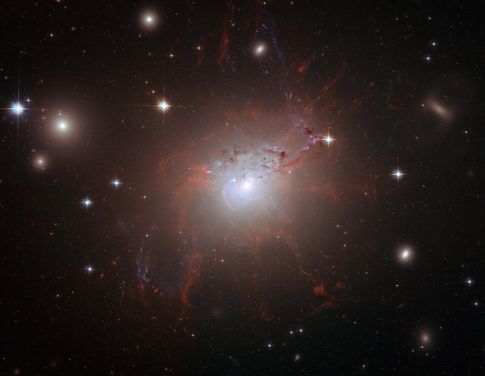For me, there's nothing quite so thrilling as a new and unexplained observation. This is doubly exciting if the people announcing it are themselves baffled by what they've found. A perfect example of this phenomenon came recently, when a pair of astronomical observations provided evidence that large magnetic fields suffuse some of the most distant observable galaxies.

Red gas filaments shaped by galaxy's magnetic field (Hubble/NASA)
It's not immediately obvious, even to many of my fellow physicists, why this is such an intriguing discovery. Magnetic fields, after all, seem largely yesterday's news: exciting for Jimmy Maxwell in the 19th century, perhaps, but now part of freshman physics, like F=ma. In the world of astrophysics, however, magnetic fields play an outsized role: they're key driver to the behavior of some of the highest energy systems in the Universe, like pulsars, magnetars and quasars.
Galactic magnetic fields are a lot more subtle. Like the wind, they're pervasive, yet still mysterious. Every galaxy we know of has a magnetic field of about the same size -- around a microGauss, almost a million times weaker than the Earth's magnetic field. Yet these galaxy-sized fields don't have any obvious source, because magnetic field generation requires something to be 1) electrically charged and 2) rotating. Galaxies are rotating, but not charged; so they must've gotten their fields from somewhere else.
But where else is there? For a long time, no one has known, exactly, though that hasn't stop people from trying to guess. I even came up with a theory myself. Most sober astrophysicists, though, suspected some bread and butter physics would eventually explain galactic magnetic fields. This is because it's pretty easy to get very, very tiny magnetic fields to form in the kind of early Universe swirls that grow up to be galaxies. These fields aren't big enough to explain the ones we see today, but that turns out to be ok: the fact that galaxies spin actually magnifies the tiny "seed" fields by a lot, through what's known as a dynamo. So if you wait around long enough, the seed fields grow into the big fields of today.
That's why these two (here and here) observations are so puzzling. Using two very different observational techniques, they both find the same thing: that very ancient galaxies, ones from when the Universe was only a third its present age, have magnetic fields that are at least as big as the magnetic fields found in galaxies today. This is exactly the opposite of what everyone expected. In the dynamo theory, you should see weaker magnetic fields in the distant past, since back then the dynamo wouldn't have had time to work.
These observations are so new that most people still don't know what to make of them. What's clear, though, is that the settled view is in trouble! And if the early Universe was highly magnetized, then we have a whole new set of things to think about. All of our standard theories of galaxy formation assume tiny fields, but if fields were big in the past, we have to rethink those theories. And we also have to confront the question: where did those big primordial fields come from?